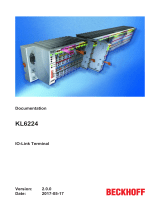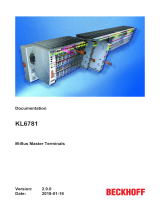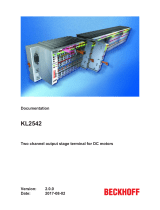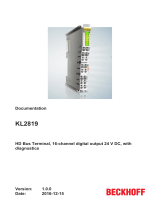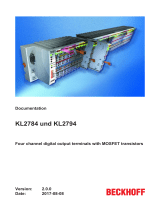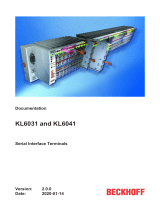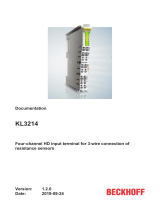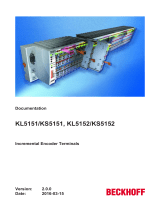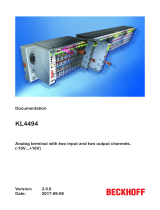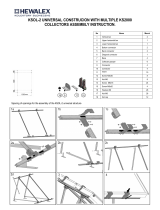Page is loading ...

Documentation
KL2791
Single channel speed controller terminals for AC motors
2.0.0
2017-08-25
Version:
Date:


Table of contents
KL2791 3Version: 2.0.0
Table of contents
1 Foreword ....................................................................................................................................................5
1.1 Notes on the documentation........................................................................................................... 5
1.2 Safety instructions .......................................................................................................................... 6
1.3 Documentation issue status............................................................................................................ 7
2 Product overview.......................................................................................................................................8
2.1 Introduction ..................................................................................................................................... 8
2.2 Basic function principles ................................................................................................................. 9
2.3 Technical data .............................................................................................................................. 10
2.4 LED displays................................................................................................................................. 11
3 Mounting and wiring ...............................................................................................................................12
3.1 Installation on mounting rails ........................................................................................................ 12
3.2 Connection.................................................................................................................................... 14
3.2.1 Connection system...........................................................................................................14
3.2.2 Wiring...............................................................................................................................16
3.2.3 Pin assignment.................................................................................................................18
3.3 Notes on operation ....................................................................................................................... 20
4 Application examples - overview ...........................................................................................................21
4.1 KL2791-0000 - application example ............................................................................................. 21
4.2 KL2791-0011 - application example ............................................................................................. 22
5 Configuration Software KS2000.............................................................................................................23
5.1 KS2000 - Introduction ................................................................................................................... 23
5.2 Parameterization with KS2000 ..................................................................................................... 25
5.3 Register ........................................................................................................................................ 27
5.4 Settings......................................................................................................................................... 28
5.5 Process data................................................................................................................................. 30
6 Access from the user program ..............................................................................................................32
6.1 Process image .............................................................................................................................. 32
6.2 Control and status bytes ............................................................................................................... 32
6.3 Register overview ......................................................................................................................... 34
6.4 Register description ...................................................................................................................... 35
6.5 Examples of Register Communication.......................................................................................... 37
6.5.1 Example 1: reading the firmware version from Register 9 ...............................................37
6.5.2 Example 2: Writing to an user register.............................................................................37
7 Appendix ..................................................................................................................................................40
7.1 Support and Service ..................................................................................................................... 40

Table of contents
KL27914 Version: 2.0.0

Foreword
KL2791 5Version: 2.0.0
1 Foreword
1.1 Notes on the documentation
Intended audience
This description is only intended for the use of trained specialists in control and automation engineering who
are familiar with the applicable national standards.
It is essential that the documentation and the following notes and explanations are followed when installing
and commissioning these components.
It is the duty of the technical personnel to use the documentation published at the respective time of each
installation and commissioning.
The responsible staff must ensure that the application or use of the products described satisfy all the
requirements for safety, including all the relevant laws, regulations, guidelines and standards.
Disclaimer
The documentation has been prepared with care. The products described are, however, constantly under
development.
We reserve the right to revise and change the documentation at any time and without prior announcement.
No claims for the modification of products that have already been supplied may be made on the basis of the
data, diagrams and descriptions in this documentation.
Trademarks
Beckhoff
®
, TwinCAT
®
, EtherCAT
®
, Safety over EtherCAT
®
, TwinSAFE
®
, XFC
®
and XTS
®
are registered
trademarks of and licensed by Beckhoff Automation GmbH.
Other designations used in this publication may be trademarks whose use by third parties for their own
purposes could violate the rights of the owners.
Patent Pending
The EtherCAT Technology is covered, including but not limited to the following patent applications and
patents: EP1590927, EP1789857, DE102004044764, DE102007017835 with corresponding applications or
registrations in various other countries.
The TwinCAT Technology is covered, including but not limited to the following patent applications and
patents: EP0851348, US6167425 with corresponding applications or registrations in various other countries.
EtherCAT
®
is registered trademark and patented technology, licensed by Beckhoff Automation GmbH,
Germany
Copyright
© Beckhoff Automation GmbH & Co. KG, Germany.
The reproduction, distribution and utilization of this document as well as the communication of its contents to
others without express authorization are prohibited.
Offenders will be held liable for the payment of damages. All rights reserved in the event of the grant of a
patent, utility model or design.

Foreword
KL27916 Version: 2.0.0
1.2 Safety instructions
Safety regulations
Please note the following safety instructions and explanations!
Product-specific safety instructions can be found on following pages or in the areas mounting, wiring,
commissioning etc.
Exclusion of liability
All the components are supplied in particular hardware and software configurations appropriate for the
application. Modifications to hardware or software configurations other than those described in the
documentation are not permitted, and nullify the liability of Beckhoff Automation GmbH & Co. KG.
Personnel qualification
This description is only intended for trained specialists in control, automation and drive engineering who are
familiar with the applicable national standards.
Description of symbols
In this documentation the following symbols are used with an accompanying safety instruction or note. The
safety instructions must be read carefully and followed without fail!
DANGER
Serious risk of injury!
Failure to follow the safety instructions associated with this symbol directly endangers the
life and health of persons.
WARNING
Risk of injury!
Failure to follow the safety instructions associated with this symbol endangers the life and
health of persons.
CAUTION
Personal injuries!
Failure to follow the safety instructions associated with this symbol can lead to injuries to
persons.
Attention
Damage to the environment or devices
Failure to follow the instructions associated with this symbol can lead to damage to the en-
vironment or equipment.
Note
Tip or pointer
This symbol indicates information that contributes to better understanding.

Foreword
KL2791 7Version: 2.0.0
1.3 Documentation issue status
Version Comment
2.0.0 • Migration
1.2.0 • Set mode leading edge phase control added
• Installation and wiring updated
• Technical data updated
• Preface updated
1.1.0 Increased power rating of 200VA for KL2791-0000 and KL2791-0011 approved
1.0.0 First public issue
0.1 First internal preliminary version
Firmware and hardware versions
Version of the
documentation
KL2791-0000, KS2791-0000,
KL2791-0011, KS2791-0011
KL2791-1200
Firmware Hardware Firmware Hardware
2.0.0 3A 05 1B 03
1.2.0 3A 05 1B 03
1.1.0 1B 03 1B 03
1.0.0 1A 00 1A 00
0.1 1A 00 - -
The firmware and hardware versions (delivery state) can be taken from the serial number printed on the side
of the terminal.
Syntax of the serial number
Structure of the serial number: WWYYFFHH
WW - week of production (calendar week)
YY - year of production
FF - firmware version
HH - hardware version
Example with ser. no.: 24 08 1A 00:
24 - week of production 24
08 - year of production 2008
1A - firmware version 1A
00 - hardware version 00

Product overview
KL27918 Version: 2.0.0
2 Product overview
2.1 Introduction
Fig.1: KL2791
In many industrialized countries, electric motors account for more than the half the current consumption,
which means there is huge energy-saving potential.
With the aid of speed control, it is quite easily possible to reduce the energy consumption to the level that is
actually required, thereby avoiding energy waste.
Beckhoff has extended its Bus Terminal system for this purpose. The KL2791 Bus Terminal is suitable for
use as a speed controller for single-phase AC motors up to 100VA.
In addition to energy conservation speed reduction offers noise reduction and increased motor service life.
The speed controller is extremely compact and is housed in a standard bus terminal with a width of 12mm.
The KL2791 Bus Terminal can be used in any bus system that is supported by the Beckhoff Bus Terminal
system.
It is designed for direct connection of low-power, single-phase AC motors.
The KL2791 enables speed reduction of typical motors such as capacitor motors, universal motors and
shaded-pole motors.
The KL2791-0011 is a version without power contacts (see ladder diagram on the right). This can be used
for 230V even without a special power feed terminal.
The KL2791-1200 is specifically designed for 120V mains voltage.
Other KS2791 variants feature pluggable wiring.

Product overview
KL2791 9Version: 2.0.0
2.2 Basic function principles
Fig.2: Basic KL2791 function principles
The motor is switched on and off with a practice-proven mains-synchronous pattern, so that the motor
consumes less power and the speed falls significantly.
This method is well suited to motors with fixed loads, such as pumps and fans, in order to achieve a control
range for the flow rate from 10% to 100%.
The KL2791 Bus Terminal enables direct connection of single-phase AC motors up to 100VA.
In this way the speed of capacitor, universal and shaded-pole motors can be reduced simply.
The set values are specified via the process data. The required output power is specified via a 16bit
representation. 3 different setting modes are available:
• Full-wave control
• Leading edge phase control is ideal for smooth operation
• Mixed control
Full-wave control is used for targeted switching on and off at optimized points in time.
This protects the connected motor and is particularly suitable for drives with a quadratic load characteristic,
such as fans or pumps.
Leading edge phase control is ideal for smooth operation.
Mixed control offers a compromise between smooth operation and motor protection.
Attention
Please follow the operation instructions
Also read the Notes on operation [}20] in the chapter Mounting and wiring.

Product overview
KL279110 Version: 2.0.0
2.3 Technical data
Technical data KL2791-0000, KS2791-0000,
KL2791-0011, KS2791-0011
KL2791-1200
Mains voltage 230V
AC
120V
AC
Power rating 200VA (W), max. 0,9A 100VA (W), max.
0,85A
Load types Single-phase AC motors
Types of control Full-wave control, mixed control
Resolution 1%
Leakage current (OFF state) < 1mA
Electrical isolation 500V (K-bus /field voltage), 3750V
AC
(1min.)
Power supply for the electronics via the K-bus
Current consumption from K-bus typically 95mA
Bit width in the input process image 1 x 16bit data, 1 x 8bit status
Bit width in the output process image 1 x 16bit data, 1 x 8bit control
Configuration via the Bus Coupler or the controller
Weight approx. 60g
Permissible ambient temperature range
during operation
0°C ... + 55°C
Permissible ambient temperature range
during storage
-25°C ... + 85°C
Permissible relative air humidity 95%, no condensation
Dimensions (W x H x D) approx. 15mmx100mmx70mm (width aligned: 12mm)
Mounting on 35mm mounting rail conforms to EN60715
Vibration/shock resistance conforms to EN60068-2-6/ EN60068-2-27
EMC immunity/emission conforms to EN61000-6-2/ EN61000-6-4
Protection class IP20
Installation position variable
Pluggable wiring for all KSxxxx terminals
Approval CE

Product overview
KL2791 11Version: 2.0.0
2.4 LED displays
Fig.3: LEDs
LED Display
K-Bus run (green) off no data transfer on the K-bus
on Data transmission on the K-bus is active
Sync (green) off • Terminal is not synchronized with the mains*
on • Terminal has synchronized itself with the mains*
ON (green) off Process data are zero
on Process data are not zero
Error (red) on A load-side overcurrent was detected
*) Synchronization with the mains can only occur if a load is connected!
WARNING
Risk of electric shock!
With the Sync LED switched off mains voltage may still be present at the KL2791 output!
At this stage, the synchronization was not yet performed!

Mounting and wiring
KL279112 Version: 2.0.0
3 Mounting and wiring
3.1 Installation on mounting rails
WARNING
Risk of electric shock and damage of device!
Bring the bus terminal system into a safe, powered down state before starting installation,
disassembly or wiring of the Bus Terminals!
Assembly
Fig.4: Attaching on mounting rail
The Bus Coupler and Bus Terminals are attached to commercially available 35mm mounting rails (DIN rails
according to EN60715) by applying slight pressure:
1. First attach the Fieldbus Coupler to the mounting rail.
2. The Bus Terminals are now attached on the right-hand side of the Fieldbus Coupler. Join the compo-
nents with tongue and groove and push the terminals against the mounting rail, until the lock clicks
onto the mounting rail.
If the Terminals are clipped onto the mounting rail first and then pushed together without tongue and
groove, the connection will not be operational! When correctly assembled, no significant gap should
be visible between the housings.
Note
Fixing of mounting rails
The locking mechanism of the terminals and couplers extends to the profile of the mounting
rail. At the installation, the locking mechanism of the components must not come into con-
flict with the fixing bolts of the mounting rail. To mount the mounting rails with a height of
7.5mm under the terminals and couplers, you should use flat mounting connections (e.g.
countersunk screws or blind rivets).

Mounting and wiring
KL2791 13Version: 2.0.0
Disassembly
Fig.5: Disassembling of terminal
Each terminal is secured by a lock on the mounting rail, which must be released for disassembly:
1. Pull the terminal by its orange-colored lugs approximately 1cm away from the mounting rail. In doing
so for this terminal the mounting rail lock is released automatically and you can pull the terminal out of
the bus terminal block easily without excessive force.
2. Grasp the released terminal with thumb and index finger simultaneous at the upper and lower grooved
housing surfaces and pull the terminal out of the bus terminal block.
Connections within a bus terminal block
The electric connections between the Bus Coupler and the Bus Terminals are automatically realized by
joining the components:
• The six spring contacts of the K-Bus/E-Bus deal with the transfer of the data and the supply of the Bus
Terminal electronics.
• The power contacts deal with the supply for the field electronics and thus represent a supply rail within
the bus terminal block. The power contacts are supplied via terminals on the Bus Coupler (up to 24V)
or for higher voltages via power feed terminals.
Note
Power Contacts
During the design of a bus terminal block, the pin assignment of the individual Bus Termi-
nals must be taken account of, since some types (e.g. analog Bus Terminals or digital 4-
channel Bus Terminals) do not or not fully loop through the power contacts. Power Feed
Terminals (KL91xx, KL92xx or EL91xx, EL92xx) interrupt the power contacts and thus rep-
resent the start of a new supply rail.
PE power contact
The power contact labeled PE can be used as a protective earth. For safety reasons this contact mates first
when plugging together, and can ground short-circuit currents of up to 125A.

Mounting and wiring
KL279114 Version: 2.0.0
Fig.6: Power contact on left side
Attention
Possible damage of the device
Note that, for reasons of electromagnetic compatibility, the PE contacts are capacitatively
coupled to the mounting rail. This may lead to incorrect results during insulation testing or
to damage on the terminal (e.g. disruptive discharge to the PE line during insulation testing
of a consumer with a nominal voltage of 230V). For insulation testing, disconnect the PE
supply line at the Bus Coupler or the Power Feed Terminal! In order to decouple further
feed points for testing, these Power Feed Terminals can be released and pulled at least
10mm from the group of terminals.
WARNING
Risk of electric shock!
The PE power contact must not be used for other potentials!
3.2 Connection
3.2.1 Connection system
WARNING
Risk of electric shock and damage of device!
Bring the bus terminal system into a safe, powered down state before starting installation,
disassembly or wiring of the Bus Terminals!
Overview
The Bus Terminal system offers different connection options for optimum adaptation to the respective
application:
• The terminals of ELxxxx and KLxxxx series with standard wiring include electronics and connection
level in a single enclosure.
• The terminals of ESxxxx and KSxxxx series feature a pluggable connection level and enable steady
wiring while replacing.
• The High Density Terminals (HD Terminals) include electronics and connection level in a single
enclosure and have advanced packaging density.

Mounting and wiring
KL2791 15Version: 2.0.0
Standard wiring (ELxxxx / KLxxxx)
Fig.7: Standard wiring
The terminals of ELxxxx and KLxxxx series have been tried and tested for years.
They feature integrated screwless spring force technology for fast and simple assembly.
Pluggable wiring (ESxxxx / KSxxxx)
Fig.8: Pluggable wiring
The terminals of ESxxxx and KSxxxx series feature a pluggable connection level.
The assembly and wiring procedure for the KS series is the same as for the ELxxxx and KLxxxx series.
The KS/ES series terminals enable the complete wiring to be removed as a plug connector from the top of
the housing for servicing.
The lower section can be removed from the terminal block by pulling the unlocking tab.
Insert the new component and plug in the connector with the wiring. This reduces the installation time and
eliminates the risk of wires being mixed up.
The familiar dimensions of the terminal only had to be changed slightly. The new connector adds about 3
mm. The maximum height of the terminal remains unchanged.
A tab for strain relief of the cable simplifies assembly in many applications and prevents tangling of individual
connection wires when the connector is removed.
Conductor cross sections between 0.08mm
2
and 2.5mm
2
can continue to be used with the proven spring
force technology.
The overview and nomenclature of the product names for ESxxxx and KSxxxx series has been retained as
known from ELxxxx and KLxxxx series.
High Density Terminals (HD Terminals)
Fig.9: High Density Terminals
The Bus Terminals from these series with 16 terminal points are distinguished by a particularly compact
design, as the packaging density is twice as large as that of the standard 12mm Bus Terminals. Massive
conductors and conductors with a wire end sleeve can be inserted directly into the spring loaded terminal
point without tools.

Mounting and wiring
KL279116 Version: 2.0.0
Note
Wiring HD Terminals
The High Density (HD) Terminals of the ELx8xx and KLx8xx series doesn't support plug-
gable wiring.
Ultrasonically "bonded" (ultrasonically welded) conductors
Note
Ultrasonically “bonded" conductors
It is also possible to connect the Standard and High Density Terminals with ultrasonically
"bonded" (ultrasonically welded) conductors. In this case, please note the tables concern-
ing the wire-size width below!
3.2.2 Wiring
WARNING
Risk of electric shock and damage of device!
Bring the bus terminal system into a safe, powered down state before starting installation,
disassembly or wiring of the Bus Terminals!
Terminals for standard wiring ELxxxx/KLxxxx and for pluggable wiring ESxxxx/KSxxxx
Fig.10: Connecting a cable on a terminal point
Up to eight terminal points enable the connection of solid or finely stranded cables to the Bus Terminal. The
terminal points are implemented in spring force technology. Connect the cables as follows:
1. Open a terminal point by pushing a screwdriver straight against the stop into the square opening
above the terminal point. Do not turn the screwdriver or move it alternately (don't toggle).
2. The wire can now be inserted into the round terminal opening without any force.
3. The terminal point closes automatically when the pressure is released, holding the wire securely and
permanently.
See the following table for the suitable wire size width.

Mounting and wiring
KL2791 17Version: 2.0.0
Terminal housing ELxxxx, KLxxxx ESxxxx, KSxxxx
Wire size width (single core wires) 0.08 ... 2.5mm
2
0.08 ... 2.5mm
2
Wire size width (fine-wire conductors) 0.08 ... 2.5mm
2
0,08 ... 2.5mm
2
Wire size width (conductors with a wire end sleeve) 0.14 ... 1.5mm
2
0.14 ... 1.5mm
2
Wire stripping length 8 ... 9mm 9 ... 10mm
High Density Terminals (HD Terminals [
}
15]) with 16 terminal points
The conductors of the HD Terminals are connected without tools for single-wire conductors using the direct
plug-in technique, i.e. after stripping the wire is simply plugged into the terminal point. The cables are
released, as usual, using the contact release with the aid of a screwdriver. See the following table for the
suitable wire size width.
Terminal housing High Density Housing
Wire size width (single core wires) 0.08 ... 1.5mm
2
Wire size width (fine-wire conductors) 0.25 ... 1.5mm
2
Wire size width (conductors with a wire end sleeve) 0.14 ... 0.75mm
2
Wire size width (ultrasonically “bonded" conductors) only 1.5mm
2
Wire stripping length 8 ... 9mm

Mounting and wiring
KL279118 Version: 2.0.0
3.2.3 Pin assignment
WARNING
Risk of injury through electric shock and damage to the device!
Bring the Bus Terminals system into a safe, de-energized state before starting mounting,
disassembly or wiring of the Bus Terminals!
Fig.11: Pin assignment
Terminal
point
No. KL2791-0000,
KL2791-1200, connection for
KL2791-0011, connection for
Output 1 Load (internally connected with terminal point 5) Load (internally connected with
terminal point 5)
L1 2 Phase (internally connected with terminal point 6
and power contact for L1)
Phase (internally connected with
terminal point 6)
N 3 Neutral conductor (internally connected with
terminal point 7 and power contact for N)
Neutral conductor (internally
connected with terminal point 7)
PE 4 Protective conductor (internally connected with
terminal point 8 and power contact for PE)
Protective conductor (internally
connected with terminal point 8)
Output 5 Load (internally connected with terminal point 1) Load (internally connected with
terminal point 1)
L1 6 Phase (internally connected with terminal point 2
and power contact for L1)
Phase (internally connected with
terminal point 2)
N 7 Neutral conductor (internally connected with
terminal point 3 and power contact for N)
Neutral conductor (internally
connected with terminal point 3)
PE 8 Protective conductor (internally connected with
terminal point 4 and power contact for PE)
Protective conductor (internally
connected with terminal point 4)
Power feed terminal
A power feed terminal can supply several speed controller terminals.

Mounting and wiring
KL2791 19Version: 2.0.0
Attention
The mains voltage should only be supplied via a power feed terminal that is
suitable for 230V
AC
/120V
AC
!
To supply the mains voltage (230V
AC
/120V
AC
) for the power contacts, it is essential to use
a power feed terminal that is designed for 230V
AC
/120V
AC
(e.g.:KL9150, KL9160,
KL9250, KL9260)!
Bus Couplers, Bus Terminal controllers and power feed terminals for 24V are not suitable
for the supply of mains voltage into the power contacts!
They are specifically designed for voltages up to 24V and would be destroyed if
230V
AC
/120V
AC
was applied to their power contacts!
Note
Separation terminal
If 24V and 230V
AC
/120V
AC
are to be used on the power contacts in a Bus Terminal block,
the KL9080 separation terminal can be used in order to clearly separate the potential
blocks visually from each other.
Short-circuit limitation
The speed controller terminals feature short-circuit limitation. The current is limited to approx. 10 to 15A.
Normally triggering of the fuse is therefore prevented.
The short circuit current flows for less than 0.5ms and is switched on automatically. After a short circuit was
detected the KL2791 tries to switch the system on again and tests the line with a low voltage. Once the short
circuit has been rectified, the speed controller terminal returns to the previous control value.
Short circuits on the line should always be avoided and never be induced deliberately! The short circuit puts
the components in the speed controller terminal under stress. A high number of short circuits reduces the
service life of the speed controller terminal!
Fuses
The speed controller terminal can be protected with fuses up to 10A.
The speed controller terminal protects itself from damage due to short circuit or overload. This built-in
protection is triggered in the event of a short circuit on the connecting line between the speed controller
terminal and the load.
Attention
Use overload protection!
However, overload protection must still be provided. The fine-wire fuse often used in de-
vices with transformers must not be bridged or changed in its value. This could lead to
overheating of the transformer.

Mounting and wiring
KL279120 Version: 2.0.0
3.3 Notes on operation
Intended use
Mains supply
The KL2791 speed controller terminal is designed for direct mains operation (230V
AC
/120V
AC
) without up-
circuit transformer.
Attention
No upstream transformers!
Excessive inductances in the supply line for the speed controller terminal lead to destruc-
tion of the speed controller terminal in the event of a short circuit!
Automatic load detection does not operate reliably with an upstream transformer.
Attention
Do not mix capacitive and inductive loads!
Capacitive and inductive loads must not be mixed at a speed controller terminal!
Setting mode
Attention
Use the correct setting mode!
Full-wave control:
As a basic principle, full-wave control is suitable for single-phase rotary AC motors.
Leading edge phase control:
In motors that are very dynamic, full-wave control can lead to unbalance. The leading edge
phase control operating mode is designed for such motors. It ensures smooth operation, al-
though under certain circumstances it may adversely affect the service life of the motor.
Mixed control:
Mixed control provides strikes a balance between full-wave control and leading edge phase
control and therefore offers a compromise between smooth operation and motor protection.
Minimum interruption of mains supply
Attention
Minimum mains interruption
Any interruption of the mains supply for the speed controller terminal may not be shorter
than 3seconds (e.g.switching off and on again of an automatic circuit-breaker)!
With shorter interruptions, the speed controller would not lose its mains synchronization
and may operate the load with the wrong control mode (dueto the switch-on edge).
With wound transformers, this may lead to destruction of the speed controller terminal!
/
